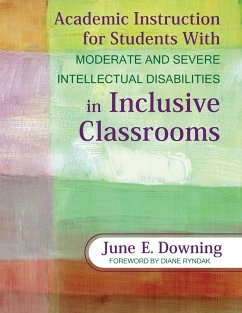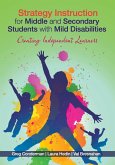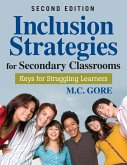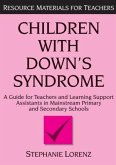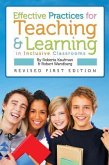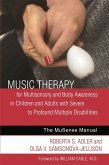June E. Downing
Academic Instruction for Students with Moderate and Severe Intellectual Disabilities in Inclusive Classrooms
June E. Downing
Academic Instruction for Students with Moderate and Severe Intellectual Disabilities in Inclusive Classrooms
- Broschiertes Buch
- Merkliste
- Auf die Merkliste
- Bewerten Bewerten
- Teilen
- Produkt teilen
- Produkterinnerung
- Produkterinnerung
Packed with instructional strategies for students with significant disabilities, this research-based resource helps teachers adapt their curriculum, work collaboratively, develop accurate assessments, track student progress, and more.
Andere Kunden interessierten sich auch für
![Intellectual Disability, Trauma and Psychotherapy Intellectual Disability, Trauma and Psychotherapy]() Tamsin Cottis (ed.)Intellectual Disability, Trauma and Psychotherapy71,99 €
Tamsin Cottis (ed.)Intellectual Disability, Trauma and Psychotherapy71,99 €![Microbial Safety of Lipid-Based Ready-To-Use Foods for Management of Moderate Acute Malnutrition and Severe Acute Malnutrition Microbial Safety of Lipid-Based Ready-To-Use Foods for Management of Moderate Acute Malnutrition and Severe Acute Malnutrition]() Food and Agriculture OrganizationMicrobial Safety of Lipid-Based Ready-To-Use Foods for Management of Moderate Acute Malnutrition and Severe Acute Malnutrition59,99 €
Food and Agriculture OrganizationMicrobial Safety of Lipid-Based Ready-To-Use Foods for Management of Moderate Acute Malnutrition and Severe Acute Malnutrition59,99 €![Strategy Instruction for Middle and Secondary Students with Mild Disabilities Strategy Instruction for Middle and Secondary Students with Mild Disabilities]() Gregory J. CondermanStrategy Instruction for Middle and Secondary Students with Mild Disabilities44,99 €
Gregory J. CondermanStrategy Instruction for Middle and Secondary Students with Mild Disabilities44,99 €![Inclusion Strategies for Secondary Classrooms Inclusion Strategies for Secondary Classrooms]() M. C. GoreInclusion Strategies for Secondary Classrooms42,99 €
M. C. GoreInclusion Strategies for Secondary Classrooms42,99 €![Children with Down's Syndrome Children with Down's Syndrome]() Stephanie LorenzChildren with Down's Syndrome57,99 €
Stephanie LorenzChildren with Down's Syndrome57,99 €![Effective Practices for Teaching and Learning in Inclusive Classrooms Effective Practices for Teaching and Learning in Inclusive Classrooms]() Roberta KaufmanEffective Practices for Teaching and Learning in Inclusive Classrooms253,99 €
Roberta KaufmanEffective Practices for Teaching and Learning in Inclusive Classrooms253,99 €![Music Therapy for Multisensory and Body Awareness in Children and Adults with Severe to Profound Multiple Disabilities Music Therapy for Multisensory and Body Awareness in Children and Adults with Severe to Profound Multiple Disabilities]() Roberta S. AdlerMusic Therapy for Multisensory and Body Awareness in Children and Adults with Severe to Profound Multiple Disabilities40,99 €
Roberta S. AdlerMusic Therapy for Multisensory and Body Awareness in Children and Adults with Severe to Profound Multiple Disabilities40,99 €-
-
-
Packed with instructional strategies for students with significant disabilities, this research-based resource helps teachers adapt their curriculum, work collaboratively, develop accurate assessments, track student progress, and more.
Hinweis: Dieser Artikel kann nur an eine deutsche Lieferadresse ausgeliefert werden.
Hinweis: Dieser Artikel kann nur an eine deutsche Lieferadresse ausgeliefert werden.
Produktdetails
- Produktdetails
- Verlag: SAGE Publications Inc
- Seitenzahl: 210
- Erscheinungstermin: 1. März 2010
- Englisch
- Abmessung: 280mm x 216mm x 12mm
- Gewicht: 594g
- ISBN-13: 9781412971423
- ISBN-10: 141297142X
- Artikelnr.: 28408420
- Herstellerkennzeichnung
- Libri GmbH
- Europaallee 1
- 36244 Bad Hersfeld
- gpsr@libri.de
- Verlag: SAGE Publications Inc
- Seitenzahl: 210
- Erscheinungstermin: 1. März 2010
- Englisch
- Abmessung: 280mm x 216mm x 12mm
- Gewicht: 594g
- ISBN-13: 9781412971423
- ISBN-10: 141297142X
- Artikelnr.: 28408420
- Herstellerkennzeichnung
- Libri GmbH
- Europaallee 1
- 36244 Bad Hersfeld
- gpsr@libri.de
June E. Downing is Professor Emerita of Special Education at California State University, Northridge, and prior to that was at the University of Arizona in Tucson, where she did research and prepared teachers to work in the area of moderate, severe, and multiple disabilities. She is a national leader in the field of special education that targets the needs of students with severe disabilities, especially with regard to inclusive education. She has published numerous articles, chapters, monographs, and seven books on students having severe and multiple disabilities. She served for six years on the Executive Board of TASH, an international advocacy organization for individuals with severe disabilities, and was a past president of the California Chapter of this organization-CalTASH as well as AZTASH. She has served as an associate editor of Research and Practices for Persons With Severe Disabilities and currently serves on this board as well as several other professional editorial boards. She is presently serving as an educational consultant, traveling extensively in the United States and abroad to do presentations on various subjects.
Foreword. by Diane Ryndak - Diane Ryndak
Preface
Acknowledgments
About the Author
1. Teaching Students With Moderate to Severe Intellectual Disabilities in
General Education Classrooms: Foundational Beliefs
Key Concepts
A Historical Perspective: Where We Came From
The Present Situation and Challenge
What is Inclusive Education?
What is Not Inclusive Education
Who Are We Talking About?
Summary
2. Instructional Strategies and Teaching Arrangements
Key Concepts
Characteristics of Effective Instruction for All Students
Clear Expectations
Analyzing Tasks for Improved Learning
What We Know About Teaching Students with Moderate to Severe Intellectual
Disabilities
The Importance of Student Interests
Components of the Teaching Task
Prompting Strategies
Consequences of the Behavior
Using Sequences of Different Prompts to Teach Students: Shaping Behavior
Maintaining and Generalizing Skills
Teaching Arrangements in General Education Classrooms
Summary
3. Determining Student Needs: What to Teach
Key Concepts
Limitations of Standardized Assessment
Family and Child-Based Assessment Procedure
Record Review
Observational Assessments
What's the Class Doing?
Interpreting Content Standards
Blending Student/Family Goals with State Standards
Identifying Learning Opportunities
Writing IEP Goals and Objectives
Summary
4. Teaching Core Curriculum to Students With Moderate to Severe
Intellectual Disabilities
Key Concepts
The Critical Need to Adapt Curriculum to Make it Meaningful
Identifying the BIG Ideas from Core Curriculum
Determining Prompts to Use for a Particular Student and Lesson
Examples of Students Receiving Direct Instruction Across Grades and
Instructional Arrangements
Large Group Instruction
Generalization of Skills Taught
Summary
5. It Takes a Village: Teaching as a Collaborative Effort
Key Concepts
The Expectation of Team Collaboration
Team Members Involved in Instruction
Credentialed Teachers
Co-Teaching
Supporting General Education Ownership
Paraprofessionals as Teachers
Related Service Providers
Parent Volunteers
Peers as Teachers
A Few Cautions When Using Peers
The Need for Information and Training
Effective Use of Team Members
The Importance of Consistency
Generalization of Skills Across Team Members
Summary
6. Keeping Track of Student Progress, by Kathryn D. Peckham-Hardin and June
E. Downing
Key Concepts
Types of Data Collection Strategies
Linking Data Collection Methods to the IEP Objectives
Collecting Data While Teaching in General Education Classrooms
Examples of Collecting Data During Instructional Times
Test Taking by the Class
Training Paraprofessionals and Others to Take Data
The Need for Alternate Assessment
Summary
7. He's Getting It! Now What? Taking Learning to the Next Level
Key Concepts
Involving the Student in Planning Next Steps
Writing IEP Objectives to Reflect Next Steps
Using Standards and Performance Indicators to Determine Next Steps
Using Task Analyses to Determine Next Steps
Using Life Needs to Determine Next Steps
Postsecondary Options
Next Steps for Nonacademic Skills
Summary
References
Index
Preface
Acknowledgments
About the Author
1. Teaching Students With Moderate to Severe Intellectual Disabilities in
General Education Classrooms: Foundational Beliefs
Key Concepts
A Historical Perspective: Where We Came From
The Present Situation and Challenge
What is Inclusive Education?
What is Not Inclusive Education
Who Are We Talking About?
Summary
2. Instructional Strategies and Teaching Arrangements
Key Concepts
Characteristics of Effective Instruction for All Students
Clear Expectations
Analyzing Tasks for Improved Learning
What We Know About Teaching Students with Moderate to Severe Intellectual
Disabilities
The Importance of Student Interests
Components of the Teaching Task
Prompting Strategies
Consequences of the Behavior
Using Sequences of Different Prompts to Teach Students: Shaping Behavior
Maintaining and Generalizing Skills
Teaching Arrangements in General Education Classrooms
Summary
3. Determining Student Needs: What to Teach
Key Concepts
Limitations of Standardized Assessment
Family and Child-Based Assessment Procedure
Record Review
Observational Assessments
What's the Class Doing?
Interpreting Content Standards
Blending Student/Family Goals with State Standards
Identifying Learning Opportunities
Writing IEP Goals and Objectives
Summary
4. Teaching Core Curriculum to Students With Moderate to Severe
Intellectual Disabilities
Key Concepts
The Critical Need to Adapt Curriculum to Make it Meaningful
Identifying the BIG Ideas from Core Curriculum
Determining Prompts to Use for a Particular Student and Lesson
Examples of Students Receiving Direct Instruction Across Grades and
Instructional Arrangements
Large Group Instruction
Generalization of Skills Taught
Summary
5. It Takes a Village: Teaching as a Collaborative Effort
Key Concepts
The Expectation of Team Collaboration
Team Members Involved in Instruction
Credentialed Teachers
Co-Teaching
Supporting General Education Ownership
Paraprofessionals as Teachers
Related Service Providers
Parent Volunteers
Peers as Teachers
A Few Cautions When Using Peers
The Need for Information and Training
Effective Use of Team Members
The Importance of Consistency
Generalization of Skills Across Team Members
Summary
6. Keeping Track of Student Progress, by Kathryn D. Peckham-Hardin and June
E. Downing
Key Concepts
Types of Data Collection Strategies
Linking Data Collection Methods to the IEP Objectives
Collecting Data While Teaching in General Education Classrooms
Examples of Collecting Data During Instructional Times
Test Taking by the Class
Training Paraprofessionals and Others to Take Data
The Need for Alternate Assessment
Summary
7. He's Getting It! Now What? Taking Learning to the Next Level
Key Concepts
Involving the Student in Planning Next Steps
Writing IEP Objectives to Reflect Next Steps
Using Standards and Performance Indicators to Determine Next Steps
Using Task Analyses to Determine Next Steps
Using Life Needs to Determine Next Steps
Postsecondary Options
Next Steps for Nonacademic Skills
Summary
References
Index
Foreword. by Diane Ryndak - Diane Ryndak
Preface
Acknowledgments
About the Author
1. Teaching Students With Moderate to Severe Intellectual Disabilities in
General Education Classrooms: Foundational Beliefs
Key Concepts
A Historical Perspective: Where We Came From
The Present Situation and Challenge
What is Inclusive Education?
What is Not Inclusive Education
Who Are We Talking About?
Summary
2. Instructional Strategies and Teaching Arrangements
Key Concepts
Characteristics of Effective Instruction for All Students
Clear Expectations
Analyzing Tasks for Improved Learning
What We Know About Teaching Students with Moderate to Severe Intellectual
Disabilities
The Importance of Student Interests
Components of the Teaching Task
Prompting Strategies
Consequences of the Behavior
Using Sequences of Different Prompts to Teach Students: Shaping Behavior
Maintaining and Generalizing Skills
Teaching Arrangements in General Education Classrooms
Summary
3. Determining Student Needs: What to Teach
Key Concepts
Limitations of Standardized Assessment
Family and Child-Based Assessment Procedure
Record Review
Observational Assessments
What's the Class Doing?
Interpreting Content Standards
Blending Student/Family Goals with State Standards
Identifying Learning Opportunities
Writing IEP Goals and Objectives
Summary
4. Teaching Core Curriculum to Students With Moderate to Severe
Intellectual Disabilities
Key Concepts
The Critical Need to Adapt Curriculum to Make it Meaningful
Identifying the BIG Ideas from Core Curriculum
Determining Prompts to Use for a Particular Student and Lesson
Examples of Students Receiving Direct Instruction Across Grades and
Instructional Arrangements
Large Group Instruction
Generalization of Skills Taught
Summary
5. It Takes a Village: Teaching as a Collaborative Effort
Key Concepts
The Expectation of Team Collaboration
Team Members Involved in Instruction
Credentialed Teachers
Co-Teaching
Supporting General Education Ownership
Paraprofessionals as Teachers
Related Service Providers
Parent Volunteers
Peers as Teachers
A Few Cautions When Using Peers
The Need for Information and Training
Effective Use of Team Members
The Importance of Consistency
Generalization of Skills Across Team Members
Summary
6. Keeping Track of Student Progress, by Kathryn D. Peckham-Hardin and June
E. Downing
Key Concepts
Types of Data Collection Strategies
Linking Data Collection Methods to the IEP Objectives
Collecting Data While Teaching in General Education Classrooms
Examples of Collecting Data During Instructional Times
Test Taking by the Class
Training Paraprofessionals and Others to Take Data
The Need for Alternate Assessment
Summary
7. He's Getting It! Now What? Taking Learning to the Next Level
Key Concepts
Involving the Student in Planning Next Steps
Writing IEP Objectives to Reflect Next Steps
Using Standards and Performance Indicators to Determine Next Steps
Using Task Analyses to Determine Next Steps
Using Life Needs to Determine Next Steps
Postsecondary Options
Next Steps for Nonacademic Skills
Summary
References
Index
Preface
Acknowledgments
About the Author
1. Teaching Students With Moderate to Severe Intellectual Disabilities in
General Education Classrooms: Foundational Beliefs
Key Concepts
A Historical Perspective: Where We Came From
The Present Situation and Challenge
What is Inclusive Education?
What is Not Inclusive Education
Who Are We Talking About?
Summary
2. Instructional Strategies and Teaching Arrangements
Key Concepts
Characteristics of Effective Instruction for All Students
Clear Expectations
Analyzing Tasks for Improved Learning
What We Know About Teaching Students with Moderate to Severe Intellectual
Disabilities
The Importance of Student Interests
Components of the Teaching Task
Prompting Strategies
Consequences of the Behavior
Using Sequences of Different Prompts to Teach Students: Shaping Behavior
Maintaining and Generalizing Skills
Teaching Arrangements in General Education Classrooms
Summary
3. Determining Student Needs: What to Teach
Key Concepts
Limitations of Standardized Assessment
Family and Child-Based Assessment Procedure
Record Review
Observational Assessments
What's the Class Doing?
Interpreting Content Standards
Blending Student/Family Goals with State Standards
Identifying Learning Opportunities
Writing IEP Goals and Objectives
Summary
4. Teaching Core Curriculum to Students With Moderate to Severe
Intellectual Disabilities
Key Concepts
The Critical Need to Adapt Curriculum to Make it Meaningful
Identifying the BIG Ideas from Core Curriculum
Determining Prompts to Use for a Particular Student and Lesson
Examples of Students Receiving Direct Instruction Across Grades and
Instructional Arrangements
Large Group Instruction
Generalization of Skills Taught
Summary
5. It Takes a Village: Teaching as a Collaborative Effort
Key Concepts
The Expectation of Team Collaboration
Team Members Involved in Instruction
Credentialed Teachers
Co-Teaching
Supporting General Education Ownership
Paraprofessionals as Teachers
Related Service Providers
Parent Volunteers
Peers as Teachers
A Few Cautions When Using Peers
The Need for Information and Training
Effective Use of Team Members
The Importance of Consistency
Generalization of Skills Across Team Members
Summary
6. Keeping Track of Student Progress, by Kathryn D. Peckham-Hardin and June
E. Downing
Key Concepts
Types of Data Collection Strategies
Linking Data Collection Methods to the IEP Objectives
Collecting Data While Teaching in General Education Classrooms
Examples of Collecting Data During Instructional Times
Test Taking by the Class
Training Paraprofessionals and Others to Take Data
The Need for Alternate Assessment
Summary
7. He's Getting It! Now What? Taking Learning to the Next Level
Key Concepts
Involving the Student in Planning Next Steps
Writing IEP Objectives to Reflect Next Steps
Using Standards and Performance Indicators to Determine Next Steps
Using Task Analyses to Determine Next Steps
Using Life Needs to Determine Next Steps
Postsecondary Options
Next Steps for Nonacademic Skills
Summary
References
Index

